Search engine visitors - click here to access entire "$ensible Home" web site
Dear Jim: I have heard about using biomass fuel to heat my home. It is supposed to be the cheapest method and good for the environment. What is it, is it really good and how can I use it to heat my home? - Ronald L.

A: Biomass is certainly not a new energy source for homes. Until about 150 years ago, nearly all homes in the United States where heated with one common source of biomass - firewood. In the world today, most homes are still heated with one of many types of biomass.
Biomass refers to any naturally-occurring organic matter which has stored energy through photosynthesis (plants using carbon dioxide, water, soil nutrients, and the sun). When you burn a log in your fireplace and feel the heat, you are basically releasing the energy stored in it from the sun.
What is new today about using biomass to heat a home is more modern methods to convert the plant material into usable heat. For example, new wood-burning fireplaces are much more efficient than they used to be. There also is other new equipment to conveniently burn a variety of biomass materials.
You mentioned the environment. A huge advantage of heating your home with biomass, particularly annual crops of corn, cherry pits, peanuts shells, sunflowers seeds, etc., is they are global warming neutral. When corn is burned, it gives off the same amount of carbon dioxide which it consumed as it grew.
Corn is one of the best sources of biomass for home heating. There are freestanding heaters and central furnaces which burn shelled corn. I use a freestanding Dell-Point Europa corn/pellet heater in my own home. I dump a 50-pound bag of corn or 40 pounds of wood pellets in each day or two. With so much corn grown in our country, it is the least expensive heating source.
We have plenty of farmland available to grow enough corn for food and heating. It takes about one acre of farmland to grow enough corn to annually heat two average homes. One ton of corn or wood pellets has enough heat content to replace three barrels of imported Middle East oil.
Wheat, oats and other grains can also be burned in one of these biomass heaters. In Michigan, waste cherry pits can be substituted for corn and they have about a 10 percent higher heat content. Sunflower and canola seeds, with their high oil content, can produce the most heat for homes.
There is a promising future for the use of switchgrass. This is a natural prairie grass which is drought-resistance and simple to grow. It can be converted into pellets, similarly to how waste sawdust made is into wood pellets. Some industrial companies now burn switchgrass in their boilers.
The following companies offer freestanding biomass heaters and whole-house furnaces: American Energy Systems (800-495-3196 www.magnumfireplace.com), Dell-Point (877-331-6212 www.pelletstove.com), Even Temp (800-331-8862 www.eventempinc.com), Ja-Ran (810-359-7985 www.ja-ran.com), and Pinnacle Pellet (800-967-9777 www.pinnaclepellet.com).
There is no Update Bulletin with this column topic.
Dear Jim: I want to do some caulking to seal up my house. I have heard that some states require low-VOC caulk and adhesive to be used. I want my family to breathe good, clean air. What is a low-VOC caulk? - Kathy E.
A: Several states now require low-VOC (volatile organic compound) materials to be used in homes. These materials often contain less than 4 percent VOC's. VOC's have been related to health problems in people.
Check the packaging label to make sure you are getting low-VOC caulk. DAP (888-327-8477) has a line of these caulks in color-coded tubes so you can identify them. You apply them just as you would any standard caulk.